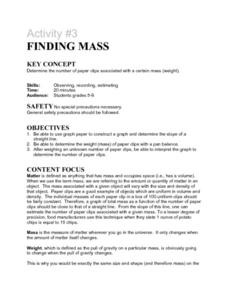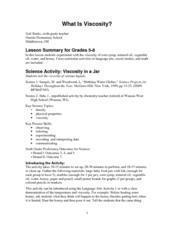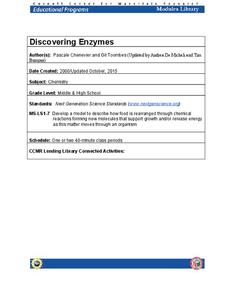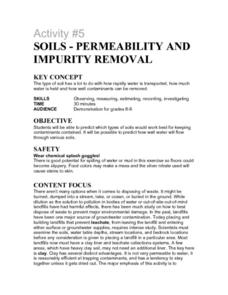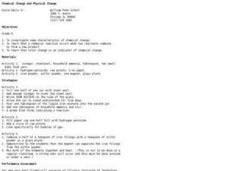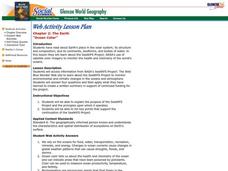Curated OER
Sour Acids and Bitter Bases
Students explore acids and bases. They experience the sour taste of acids and the bitter taste of bases by tasting substances such as chocolate, lemon juice, and baking soda. in addition, they complete a worksheet for individual assessment.
Curated OER
Activity #3 Finding Mass
Students use graph paper to construct a graph and determine the slope of a straight line. They determine the weight (mass) of paper clips with a pan balance. Pupils weigh an unknown number of paper clips, and to interpret the graph to...
Curated OER
Condensation and the Water Cycle
Students explore the natural distallation process that occurs in the water cycle. They use plastic cups and cotton swabs to observe the condensation process that is evident in the water cycle.
Curated OER
Parallel Structure Practice
Practice parallel structure with a multiple-choice exercise. Twenty questions challenge learners of all ages to correctly fill in blanks with phrases that are parallel in structure to what is already there. Tip: As noted, this worksheet...
Teach Engineering
Edible Algae Models
Sometimes it's okay to eat your science experiment. A hands-on activity has pupils create models for algae to learn about its cellular structure. The best part of the experiment? The resulting juice-filled gels are edible—yum!
Polar Trec
What Is My Footprint?
How do one's habits and lifestyle choices affect the environment? Through a short online survey, learners will calculate their own carbon footprints then determine how to reduce their impact on the environment through simple steps, such...
Exploratorium
Your Sense of Taste
A simple and sweet activity shows students how important smell is in interpreting flavor. Pairs of pupils hold their noses and eat Life Savers®, only to find that they can't identify the flavors until they let go. You will appreciate...
Beyond Benign
SLS Toxicology Test
Ingredients in your shampoo are toxic enough to kill plants. The 16th installment of the series of 24 tests the toxicity level of various concentrations of SLS, a chemical found in nearly all shampoo. Learners prepare percent solutions...
Curated OER
What Is Viscosity?
Students experiment with the visocosity of corn syrup, mineral oil, vegetable oil, water, and honey. They research viscosity before beginning. Pupils draw the conclusion that the marble sinks more slowly in the liquids with greater...
Cornell University
Discovering Enzymes
Explore the function of enzymes through a series of lab investigations. Learners use household enzymes such as hydrogen peroxide to model the role of enzymes. The enzymes break down proteins with and without a catalyst.
Curated OER
Activity #17 Liquid Density and Temperature
Students comprehend that hot water rises up through cold water but cold water does not rixe in hot water. They comprehend that water at temperatures above 4oC decreases in density with increases in temperature. Students answer lab...
Curated OER
What Changes Occur When Water Freezes?
Students investigate the changes that occur at the molecular level when a liquid becomes a solid. They freeze water in baby jars and observe the changes that occur in the process.
Curated OER
Activity #5 Soils-Permeability and Impurity Removal
Students predict which types of soils would work best for keeping contaminants contained. They comprehend that in the past, landfills have been one major source of groundwater contamination. Pupils comprehend that placing and building...
Curated OER
Basic Subtraction Facts
In this basic subtraction facts worksheet, students problem solve and calculate the answers to twenty subtraction equations. Students double-check their answers with their classmates.
Curated OER
Investigating Properties of Water: Temperature
Investigate how temperature affects the density of water and stratification that occurs in bodies of water when temperatures vary. Water of differing temperatures is given different colors to see the layers that form. The lesson is meant...
Curated OER
Capillary Action and Adhesion
Students perform classroom experiments to observe adhesion. They perform a second experiment using sand, salt, water, and a heat lamp to observe the principle of capillary action. They also experiment with adhesion in plants.
Curated OER
The Effects of Temperature Variations on the Heartbeat Rate of Daphnia
Students use DigiScope technology to investigate Daphinia, popularly known as water fleas. They design, conduct, and report on an experiment to determine the effects of varying water temperatures on the heartbeat rate of Daphnia.
Curated OER
Chemical Change and Physical Change
Sixth graders combine chemicals to create a chemical change. In this chemicals lesson plan, 6th graders will investigate characteristics of chemical change by combining chemicals. They will learn that color change is an indicator of...
Curated OER
Indra Nooyi
In this Indra Nooyi worksheet, students read about the life of the CEo of Pepsi, then complete a variety of comprehension activities. An answer key is included.
Curated OER
Raindrops Keep Burning On My head
Students investigate the effects and causes of acid rain. They test pH of household items to familiarize themselves with pH scale and compare that information with acid rain solutions. They investigate impact of acid rain via internet...
Curated OER
Intermediate Sentence Completion 15
In this sentence completion worksheet, students read the sentences and choose the best word to complete each sentence. Students complete 12 sentences.
Curated OER
Marie Curie
In this famous person worksheet, students read a passage about Marie Curie and then complete a variety of in-class and homework activities to support comprehension, including partner interviews, spelling, cloze, synonym...
Curated OER
Ocean Color
Students examine NASA's SeaWiFS Project Web site to explore how the SeaWiFS Project monitors environmental and climatic changes in the oceans and atmosphere. They answer questions and write a summary in support of continued funding for...
Curated OER
Pigment Plucking
Students examine pigments found in different fruits and vegetables and practice the processes for extracting the pigments. Pigments are used to create artwork and a class PowerPoint presentation is made on the different types of plant...
Other popular searches
- 4th Grade Food Chemistry
- Food Chemistry Pdf
- Food Chemistry Quiz
- Food Chemistry Pancakes
- Food Chemistry Protein
- Food Chemistry Detection
- Food Chemistry Mcq
- Food Chemistry Pd
- Food Chemistry Cakes
- Food Chemistry Protien
- Food Chemistry Mc
- Food Chemistry Pancackes

